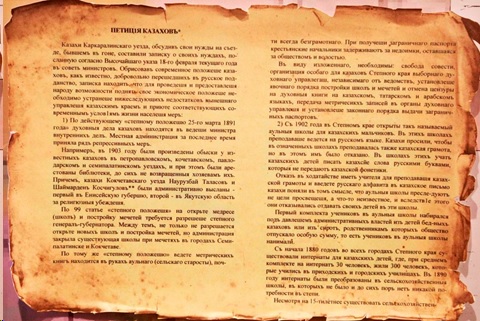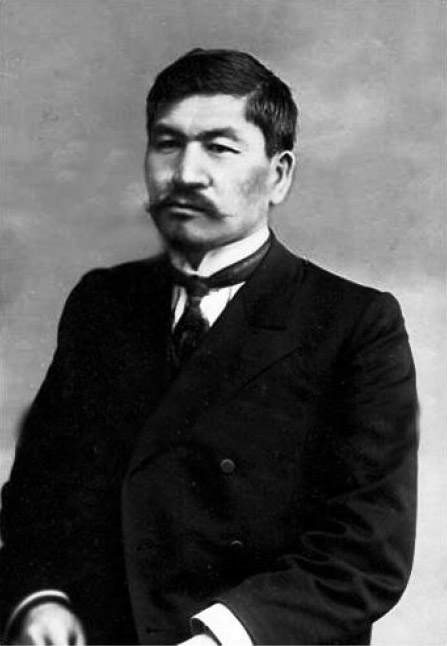Меню
Страницы
Статья
Alash political movement
Every nation in historical retrospect goes through a stage of increasing political maturity. In the history of Kazakhstan, this period fell at the beginning of the XX century. Heavy colonial oppression, the seizure of fertile lands from the Kazakhs, the resettlement of peasants to the steppe by the tsarist government became the reasons for the emergence of a national movement. Initially, the movement announced its demands and goals by writing the Karkaraly petition on July 22, 1905. It was signed by outstanding figures of the Kazakh people - Akhmet Baitursynov, Alikhan Bokeikhanov, Myrzakyp Dulatov, Zhakyp Akpayev. In the Karkaraly petition, demands were made for freedom of conscience, the organization of education in the Kazakh language, the rejection of the resettlement policy and the return of lands to the Kazakhs. The petition was addressed to Emperor Nicholas II, as well as more than 15 thousand people signed it. For the Kazakh steppe, this petition was very important, as it covered the entire spectrum of problems, and became, in fact, a program article of the national movement.

Karkaraly petition
At the end of 1905, a congress of delegates from five regions of Kazakhstan was held in the city of Uralsk, where was decided to organize a national movement. This movement was called «Alash», which has a sacred meaning for the Kazakhs. According to legend, the ancestor of all Kazakhs – Alash Khan wore this name and the Kazakhs used this name as their own battle cry. The national movement united poets, writers, and publicists. In total, it included more than two hundred thousand people across the steppe. In order to convey their thoughts and ideas to the people, the national intelligentsia began to issue printed publications - newspapers and magazines. Consequently, in 1907 two newspapers began to publish "Kazakh newspaper" and «Serke». In 1911, the magazine «Aykap» began to appear, the editor-in-chief of which was Mukhamedzhan Seralin. Under the editorship of Akhmet Baitursynov, the Kazakh newspaper was published in the period 1913-1918. It can be noted that each of the periodicals was used by the national movement «Alash» to implement its Karkaraly program.
From July 21 to July 28, 1917, the First All-Kazakh Congress was held in the city of Orenburg. One of the important issues that was considered by the congress and supported by all the delegates was the registration of the Alash movement into a political party. The leaders of the party were Alikhan Bokeikhanov, Halel Gabbasov, Aidarkhan Turlybayev. The creation of the party was first announced in the newspaper «Saryarka», which was published in the city of Semey, and the editor-in-chief was Alimkhan Ermekov. The political party «Alash» has put forward X points for the organization of a firm government:
- Formation of national autonomy;
- Assigning autonomy to the name «Alash»;
- The entire territory of the future autonomy, as well as its subsoil, was declared the property of all people;
- The Constitution of the future autonomy was approved by the All-Russian Constituent Assembly;
- Guaranteeing the rights of all national minorities;
- Creation of the People's Council of autonomy of 25 members, 10 of whom must be Russian;
- Creation of the People's militia (police);
- Holding of general elections on the territory of the autonomy;
- Autonomy should have the right to make loans, negotiate with neighbors;
- Drafting the Constitution of Autonomy.
In October 1917, a revolution took place, because of which the Soviets (red) and the White government began to fight for power. The leaders of the national intelligentsia and the Alash party did not accept the ideas of the Soviets, and from December 5 to December 13, 1917, the Second All-Kazakh Congress was held in the city of Orenburg. At this congress, the creation of a national state was proclaimed – the Alash autonomy, or Alash Horde. Alikhan Bokeikhanov was elected the leader of the state, and the city of Semey was elected the capital.

Alikhan Bokeikhanov
In March 1918, members of the government of Alash-Orda – Khalel Dosmukhamedov and Zhansha Dosmukhamedov negotiated with V. Lenin and I. Stalin on granting the Kazakhs national autonomy by the Bolsheviks, which were unsuccessful. Therefore, in order to strengthen their state, as well as its development, the leaders of the Alash-Orda began to actively cooperate with the White Movement that opposed the Soviet government. It was decided to organize military units of the Alash autonomy to organize the repulse of the Soviet Red Army. In 1918, horse regiments were formed everywhere in the cities of Kazakhstan – Kostanay, Uralsk, Orenburg, Semey.

Mounted regiment of the Alash autonomy
As part of the opposition to the Soviet government, a resolution was adopted in Alash-Orda in June 1918, according to which all decrees of the Soviets on the territory of the Alash autonomy were recognized as invalid.
Unfortunately, the leader of the Russian White Movement, Admiral A. Kolchak, did not support the national autonomy of the Kazakhs, and by 1919 the population of the steppe itself began to support the red government of the Soviets, which relied on socialist ideas.
In December 1919, the Alash Horde was forced to submit to the Soviets, and some of its leaders, such as Akhmet Baitursynov, Smagul Sadvokasov, began to actively integrate into the Soviet system of government. Already in 1920, the Alash Horde was liquidated by the Bolsheviks, and its leaders and supporters received a full amnesty. The Kazakh Autonomous Soviet Socialist Republic was proclaimed on the territory of Kazakhstan.
For Kazakhs, the leaders of the Alash movement were not only political figures, but also educators, scientists. So, after the liquidation of the Alash Horde, its leader, Alikhan Bokeikhanov, lived in Moscow, and was a literary employee of the Cossack section of the Central Publishing House of the Peoples of the USSR, Khalel Dosmukhamedov was engaged in healthcare and publishing, and Magzhan Zhumabayev, actually stood at the origins of the creation of the Union of Writers of Kazakhstan.
The fate of all the leaders and members of Alash was tragic – they were shot during the Stalinist terror in 1937-1939. Of all the figures of the Alash Horde, only Alimkhan Ermekov was not shot.
The leaders and participants of the national movement "Alash" set noble goals – bringing freedom to their own people and getting rid of colonial oppression. Unfortunately, having insufficient resources, as well as not finding full support from its allies - the White Movement, the Alash state was liquidated.

Government of Alash-Orda in Semey